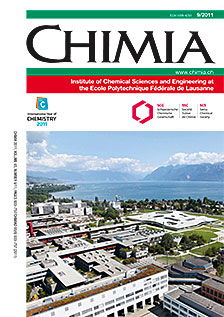Study of the pO2-Sensitivity of the Dendrimeric and Free Forms of Pd-meso-tetra(4-carboxyphenyl)porphyrin, Incorporated or not in Chitosan-Based Nanoparticles
DOI:
https://doi.org/10.2533/chimia.2011.691Keywords:
Chitosan, Nanoparticle, Oxygen partial pressure, Oxyphor, Phosphorescence quenchingAbstract
The concentration of oxygen and its rate of consumption are important factors in certain medical treatments, such as radiotherapy and photodynamic therapy (PDT). Measuring the tissue concentration of oxygen or its partial pressure (pO2) can be achieved by taking advantage of the oxygen-dependent luminescence lifetime of certain molecules, including metallo-porphyrin derivatives, due to the oxygen-dependent quenching of their triplet state. Unfortunately, most of these porphyrin derivatives are phototoxic due to the O21? produced in the pO2 measurement procedure. The aim of this work was to characterize new nanoparticle oxygen sensors, where the palladium-porhyrin molecule (Pd-meso-tetra(4-carboxyphenyl)porphyrin) or its dendrimer form, is incorporated into an oxygen permeable matrix of chitosan-based colloidal particles. It was hypothesized that the reactive O21? produced during the pO2 measurement would react inside the particle thus reducing its toxicity for the surrounding tissue, whereas the 3? ground state of O2, that is to be measured, would diffuse freely in the peptide. We observed that the incorporation of the porphyrin in the nanoparticles resulted in a reduction of the phosphorescence lifetime sensitivity to pO2 by about one order of magnitude. Our studies of these new sensors indicate that the oxygen concentration can be measured in aqueous solutions with a precision of ±20% for oxygen concentrations ranging between 0% and 25%.Downloads
Published
2011-09-30
Issue
Section
Scientific Articles
License
Copyright (c) 2011 Swiss Chemical Society

This work is licensed under a Creative Commons Attribution-NonCommercial 4.0 International License.
How to Cite
[1]
P. Nowak-Sliwinska, P. Käuper, H. van den Bergh, G. Wagnières, Chimia 2011, 65, 691, DOI: 10.2533/chimia.2011.691.







